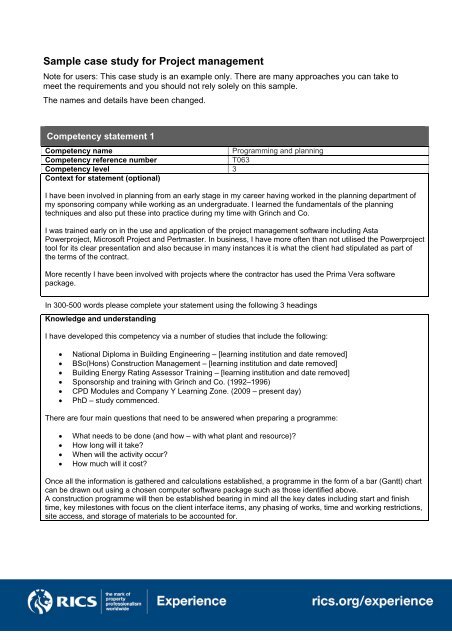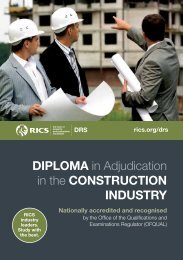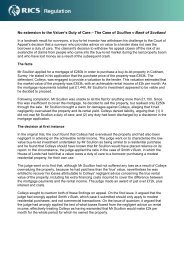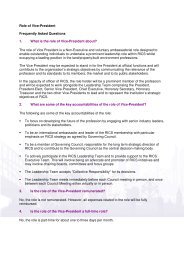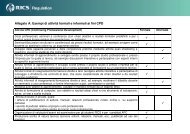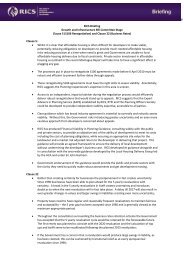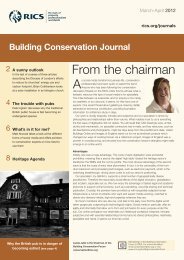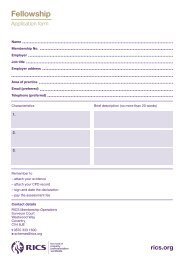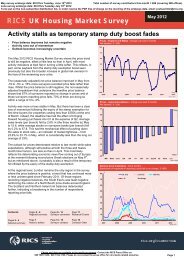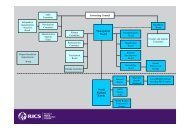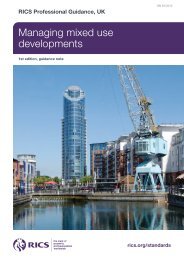RICS Project Management - PER Sample Submission
RICS Project Management - PER Sample Submission
RICS Project Management - PER Sample Submission
You also want an ePaper? Increase the reach of your titles
YUMPU automatically turns print PDFs into web optimized ePapers that Google loves.
<strong>Sample</strong> case study for <strong>Project</strong> management<br />
Note for users: This case study is an example only. There are many approaches you can take to<br />
meet the requirements and you should not rely solely on this sample.<br />
The names and details have been changed.<br />
Competency statement 1<br />
Competency name Programming and planning<br />
Competency reference number T063<br />
Competency level 3<br />
Context for statement (optional)<br />
I have been involved in planning from an early stage in my career having worked in the planning department of<br />
my sponsoring company while working as an undergraduate. I learned the fundamentals of the planning<br />
techniques and also put these into practice during my time with Grinch and Co.<br />
I was trained early on in the use and application of the project management software including Asta<br />
Powerproject, Microsoft <strong>Project</strong> and Pertmaster. In business, I have more often than not utilised the Powerproject<br />
tool for its clear presentation and also because in many instances it is what the client had stipulated as part of<br />
the terms of the contract.<br />
More recently I have been involved with projects where the contractor has used the Prima Vera software<br />
package.<br />
In 300-500 words please complete your statement using the following 3 headings<br />
Knowledge and understanding<br />
I have developed this competency via a number of studies that include the following:<br />
National Diploma in Building Engineering – [learning institution and date removed]<br />
BSc(Hons) Construction <strong>Management</strong> – [learning institution and date removed]<br />
Building Energy Rating Assessor Training – [learning institution and date removed]<br />
Sponsorship and training with Grinch and Co. (1992–1996)<br />
CPD Modules and Company Y Learning Zone. (2009 – present day)<br />
PhD – study commenced.<br />
There are four main questions that need to be answered when preparing a programme:<br />
What needs to be done (and how – with what plant and resource)?<br />
How long will it take?<br />
When will the activity occur?<br />
How much will it cost?<br />
Once all the information is gathered and calculations established, a programme in the form of a bar (Gantt) chart<br />
can be drawn out using a chosen computer software package such as those identified above.<br />
A construction programme will then be established bearing in mind all the key dates including start and finish<br />
time, key milestones with focus on the client interface items, any phasing of works, time and working restrictions,<br />
site access, and storage of materials to be accounted for.
Practical application of knowledge and understanding<br />
Grinch and Co – Planning Engineer<br />
I initially worked with Company X in the tender department – producing programmes using Asta Power<br />
<strong>Project</strong> software on a number of construction projects. This entailed network analysis, critical path identification<br />
and also illustration of programme float.<br />
Barchester Developments – Client <strong>Project</strong> Manager<br />
One of the key aspects of working as the client project manager was to prepare monthly project management<br />
“monitoring” reports. These were the formal way of communicating to the client – in addition to meeting minutes<br />
every second week – of how the project was progressing.<br />
One of our roles was to interrogate a contractor’s programme. The experience gained with Grinch and Co<br />
concerning critical path and float enabled an understanding to ensure the contractor was programming in the<br />
most optimal and efficient sequence – particularly when it came to impacts of design information being attributed<br />
to contractor programme delay.<br />
Cost Report summary detailing the current estimated Final <strong>Project</strong> Cost and how it compared with the Contract<br />
sum.<br />
Reasoned advice (Level 3 where selected)<br />
I recognise that one of the key skills of a project manager is the ability to focus management attention on those<br />
aspects of a problem that most require attention and not waste effort on parts of the project that are insignificant<br />
when compared to the total outcome. When I came to the Dotheboys Hall school project earlier this year, it was<br />
evident to me that significant work was required to address the fire strategy out of which all design deliverables<br />
would be progressed to a conclusion. The client was advised to sanction additional funds for this critical element<br />
of the design.<br />
Last Planner documents are prepared on a weekly basis to co-ordinate the works and inform the team in a<br />
formal manner of the works to be undertaken in the short term – this document is also communicated to the<br />
client for information. This provides a greater visibility to the client pertaining to actual progress on a weekly<br />
basis, and impact on the overall construction programme.<br />
Working as project manager for Goldstone plc on a superstore in a retail park – requiring demolition while leaving<br />
the store operational in part – required detailed input into having the critical elements of the works progressed.<br />
We were able to advise and minimise the disruption in operation to the store.
Case study 1<br />
Context (optional) not included within the word count<br />
<strong>Project</strong>: Upgrade of baggage screening facility<br />
Client: Barry Sheen Airport (BSA) Isle of Man<br />
Value: [removed]<br />
Role: <strong>Project</strong> Manager – design and build contract with NEC 3 Option C form with Target Cost. The role was<br />
project manager for BSA to deliver 19no phases of a new baggage system upgrade to meet new compliance<br />
requirements. The project was undertaken in a live environment.<br />
Introduction<br />
The programme commenced in [date removed] and is due for full completion by [date removed]. The biggest<br />
challenge of this project was the fact that the works were to be carried out in a “live” operational environment.<br />
As project manager, taking over from the previous PM, the learning curve was steep and having not worked<br />
with the NEC form of contract Option C Target Cost previously, this presented further but ultimately interesting<br />
challenges.<br />
The objective of the project was to present upgraded security facility to the baggage system that utilised<br />
significantly less space within the baggage hall and entailed the relocation of baggage handling agents to other<br />
parts of the baggage facility with stakeholder consensus.<br />
Case study – 500-1000 words<br />
2.0 Construction Phasing<br />
The construction programme was established and the first element was to identify the key milestones and<br />
implications of the programme phasing. There were a number of key drivers to this, and milestone dates that<br />
triggered the implementation of contractual Liquidated and Ascertained Damages (LADs) for not achieving<br />
particular dates.<br />
The key aspect of this incorporated establishing the critical path – this identified the key element in this<br />
as being the procurement of the baggage system elements and sign off of design deliverables<br />
applicable thereto.<br />
3.0 Scope of works<br />
As the scope was extensive, for the purpose of illustration I have highlighted only some of the key elements<br />
with elaboration. The procurement of these in a timely manner was essential for the smooth flow and sequence<br />
of operations and objectives of the programme:<br />
Asbestos Identification and Removal<br />
o Engagement and reporting of a specialist consultant for areas in advance of construction<br />
phasing.<br />
Demolition and Clearance<br />
o Identification via the Health and safety plan for asbestos, structural validation and service<br />
isolations in advance of works.
Groundworks<br />
o Substructure concrete – key aspect included identification of make up of ground cover above<br />
service tunnel using CAT facility and pilot holes and core to determine make up that influenced<br />
the concrete design over same to accommodate the 3Tonne baggage security machine<br />
located above.<br />
o Drainage works – solution required to ensure maintenance strategy was improved from current<br />
situation.<br />
Survey works<br />
o Structural – validation required of the existing structure and implication of removal of structure<br />
in a sequence to suit the phasing.<br />
o Mechanical and Electrical – service isolations and capacities identified, future proofing for later<br />
phasing and validation of existing design.<br />
Fire strategy<br />
The fire engineering process was a key element that is highlighted as a result of the brief being<br />
ambiguous. I advised the client we would have to engage the service of a specialist fire engineering<br />
consultant to advise and assist in the progress of a solution to have a design established to meet the<br />
requirements of the Building Control Officer (BCO) requirements.<br />
Surveys and records of the existing building were either outdated, not in existence or inaccurate. In<br />
order to protect the interests of the client business and operations, a clear strategy and plan was<br />
agreed for implementation. This exercise alone entailed detailed 3D modelling and simulation to<br />
identify clash detection of structure and services, i.e. to ensure clear headroom for walkways within the<br />
restricted baggage hall facility.<br />
The process enabled design solutions to be driven out for the remaining design deliverables and the<br />
advice was bought into by the client.<br />
Service isolations<br />
Removal of conveyors<br />
Installation of conveyors<br />
Installation of new security and x-ray machines<br />
Traffic management and re-location<br />
Logistics management and interface with existing operations was critical in terms of management of<br />
traffic routes and flow of baggage dollies and tugs within the busy live airport environment. Access to<br />
the emergency services maintained. Rigid health and safety controls were maintained with the isolation<br />
of the construction site works made clear through demise and physical barriers.<br />
Signage – including re-routing of traffic during relocation of baggage handling operations.<br />
Lighting and HVAC<br />
Cladding<br />
Roller shutter doors<br />
Road surfacing<br />
Decoration<br />
Structural steel<br />
Stairs and walkovers – impact of same on fire escape routes and service / structural interface<br />
Partitions, doors and fit out of offices
Testing and Proving of Systems<br />
o Series of Acceptance tests established<br />
o System integration testing<br />
o Client approval tests<br />
o Confidence trials and training<br />
4.0 Design Deliverables<br />
As part of the agreed contract documentation – Working <strong>Project</strong> Execution Plan (WPEP) – a clear set of design<br />
deliverables were established at the project outset. These entailed having design deliverables being<br />
progressed to scheme design stage and signed off by the key stakeholders within GAL in a timely manner.<br />
Failure to meet the required dates would lead to imposing LADs on to the company as the design and build<br />
contractor.<br />
Summary of objectives leading to detailed design approval:<br />
Controlling change within budget<br />
Co-ordinating elements not in contracts<br />
Presenting detailed proposals for approval<br />
Developing final project plan with programme (and costs if deviation)<br />
Preparation of report with recommendation<br />
In selecting and comparing a design solution to maximise value and meet project brief and planning consent<br />
requirements, the following are some of the key activities that were involved:<br />
Appointment of team resources including specialists, i.e. fire engineering<br />
Health and Safety Plan – development from the CDMC collected data that informed designer risk<br />
assessments<br />
Planning consultations with Building Control Officer<br />
Specialist supply chain engagement and analysis of design to ensure safe, economic and efficient<br />
construction.<br />
Programme studies – to identify key constraints and dependencies, and long lead activities.<br />
Change control – formal process of identifying a need to change the project brief and devaluating the<br />
effects for Client Approval.<br />
Risk <strong>Management</strong><br />
This entailed the ongoing maintenance of a risk register entailing risk analysis and contingency plans<br />
for hazards outside of the direct control of the Client or <strong>Management</strong> team.<br />
The biggest impact was failure to meet a deadline after our Client had committed to a 3rd party airline<br />
that the new line and handling facility would be ready by a certain time.<br />
The Confidence Trial was a mechanism of ensuring for a 7-day period, we would provide standby<br />
operatives and supervisors to “unblock” and rectify any difficulties associated with integration of the<br />
new line into the baggage system.<br />
5.0 <strong>Project</strong> <strong>Management</strong> Controls<br />
The implementation of our management controls were managed through the following:<br />
<strong>Project</strong> Execution Plan (PEP)<br />
Programmes – established at the appropriate level for reporting in accordance with the GAL<br />
requirements, i.e. from level 1 to level 4.
Meetings and workshops held weekly and attended by me as the contractor PM lead:<br />
o Client meetings convened weekly<br />
o Design Team meetings<br />
o Health and Safety meetings<br />
o Last Planner meetings with contractors – weekly and 4-weekly look-ahead / coordination<br />
o Internal company meetings – leadership and teamwork<br />
Client Reports – I was responsible for preparing monthly client reports to include the following:<br />
o Commercial headlines<br />
o Critical issues<br />
o Programme and Progress (P6 Primavera)<br />
o Design<br />
o Contractual Issues (NEC 3 Option C Target Cost)<br />
Early Warning Notices (EWN)<br />
Compensation Event Notification (CEN)<br />
<strong>Project</strong> <strong>Management</strong> Instruction (PMI)<br />
o Risk and Opportunities<br />
o Procurement status<br />
o Health and Safety Reports and Initiatives<br />
Safety First Second Nature (SFSN)<br />
Behavioural <strong>Management</strong> and Observation Studies (BMOS)<br />
Please list the core and optional competencies and mandatory competencies demonstrated in the case study<br />
Core competencies Optional competencies Mandatory competencies<br />
Construction technology and Commercial management of Client care<br />
environmental services<br />
construction<br />
Leadership Communication<br />
Managing people Conduct rules, ethics and<br />
professional practice<br />
Procurement and tendering Conflict avoidance, management<br />
and dispute resolution procedures<br />
Programme and planning Health and safety<br />
Risk management Teamworking


